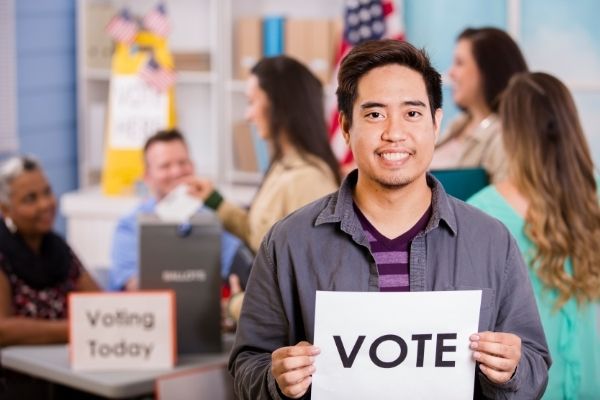Guest Blog By Terry Ao Minnis and Anika Raju

2020 was an incredibly unique year filled with unprecedented challenges, but Asian Americans Advancing Justice | AAJC stepped up and adapted quickly. The COVID-19 pandemic posed numerous public health concerns, which many states addressed in part by expanding access to vote-by-mail. This culminated in an increase in citizens who voted by mail during the election. Now, vote-by-mail has become the target of increased efforts to delegitimize votes and suppress the voices of Asian American and other communities of color.
To ensure all voices were heard, we teamed up with APIA Vote to once again host the 1-888-API-VOTE hotline, an election protection hotline dedicated to assisting voters in English plus eight Asian languages. We also provided translated factsheets about the election, including state-specific factsheets for certain states that outlined important voting processes and procedures to ensure that citizens with limited English proficiency had the knowledge and resources needed to exercise their right to vote.
Since last year, we have focused on passing the John Lewis Voting Rights Advancement Act, which would restore and modernize provisions of the 1965 Voting Rights Act that were gutted in the 2013 Shelby County v. Holder decision. In addition to reviving the pre-clearance formula, which would require jurisdictions with a history of voter suppression to obtain pre-approval from the Justice Department or federal courts before making changes to their election processes, the bill also includes a complementary provision, known as practice-based pre-clearance, that targets the known practices policymakers have used repeatedly against growing minority electorates.
Q: Historically, what have been the biggest hurdles to ensuring Asian American communities are ready, and able, to vote?
A: Language access is a major issue in the Asian American community. 65.7% of the Asian American population is foreign born, and not all are proficient in English. 73.5% of Asian Americans speak a language other than English at home, and almost 1 in 3 Asian Americans are limited English proficient. Voting materials are generally written at a 12th grade level of comprehension – a higher level of comprehension than naturalization materials are written in. Consequently, some naturalized citizens might face challenges when attempting to vote. Advancing Justice | AAJC, however, has seen that these challenges can be overcome when Section 203 of the Voting Rights Act – which requires the provision of language assistance in certain places – is properly implemented.
Along with the issue of language access, Asian Americans face barriers due to the “perpetual foreigner” stereotype, which otherizes Asian Americans and paints them as a group that cannot be fully American. The stereotype that Asian Americans or not “real” or “full” Americans has led to hostility and suspicion from poll workers; Advancing Justice | AAJC has noted incidents of poll workers as well as voter challengers assuming that Asian American voters are not eligible to vote.
Historic engagement of Asian American voters in Georgia is a microcosm of what can be accomplished nationwide when needs of communities are identified and addressed.
Q: What have we learned from the historic engagement of Asian American voters in 2020, especially in the South?
A: We saw a record turnout of Asian American voters in 2020, with the number of eligible Asian American voters more than doubling over the last two decades. Asian Americans represented the largest increase in voter turnout rates in 2020 among all groups; 59% reported voting in 2020, compared to 49% in 2016. Voter registration for the community also increased significantly with a rate of 64% – an eight percent increase from the last presidential election.
Similarly we saw increases in the South, which had some of the fastest growing Asian American communities the previous decade. Overall there was a 63.3% registration rate and a 59.4% turnout rate for Asian Americans in the South, as defined by the Census Bureau. This engagement by Asian Americans helped make the difference in places like Georgia, where AAPI voters encompassed a larger share of votes by mail than any other racial group. During the general election, nearly 40% of AAPI voters used mail-in voting, compared to about 26% of all voters on average. During the runoff elections, over 34% of AAPI voters used vote-by-mail, compared to less than 24% of all voters on average.
This engagement demonstrated the power that Asian Americans can wield and would not have been possible without the organizers who prioritized the needs of AAPIs and other communities of color. Among these organizers was our Georgia affiliation, Advancing Justice | Atlanta, which provided in-language resources and on-the-ground voter support this past election cycle. The Georgia runoff elections demonstrate the importance of providing education and resources to marginalized communities to ensure that all voices are heard equally. Historic engagement of Asian American voters in Georgia is a microcosm of what can be accomplished nationwide when needs of communities are identified and addressed.
Q: Though violence against Asian Americans is nothing new, why do you think there was more mainstream attention to anti-Asian hate, including #StopAsianHate social media advocacy?
The latest wave of hate is the result of years of attacks on immigrant communities by the Trump Administration and racist rhetoric by other elected officials related to the COVID-19 pandemic. While anti-Asian racism has manifested in this country’s policies and practices since the beginning of U.S. history – including with the Chinese Exclusion Act of 1882; the incarceration of over 120,000 Japanese Americans during World War II; and the scapegoating of and violence against Arab, Middle Eastern, Muslim, and South Asian communities after 9/11 – the normalization of anti-Asian rhetoric over the past five years has contributed to the increased acts of hate and violence against Asian Americans this past year.
Racism against Asians and Asian Americans is not a new phenomenon; it is part of the deep structural racism that has long impacted communities of color. Along with the rise in anti-Asian hate, we saw increased incidents of hate and violence against people of color in general this past year, including increased police brutality against the Black community. The summer of 2020 was marked by the murders of George Floyd and Breonna Taylor, followed by Black Lives Matter protests all over the country. The unjust killings and resulting protests propelled an increase in awareness of racial justice issues – an awareness in which many who were previously silent were voicing their outrage and calling for justice.
The protests marked a turning point in the racial justice movement of recent history, and that momentum continued in the months following. With the rise of shareable and accessible social media tools like slide decks and Instagram stories, online and digital advocacy has become an even larger instrument in activism. The increasing use of social media as a tool for activism, plus its far-reaching impact, were vital in bringing attention to racial justice issues and maintaining momentum both within advocacy and activism spaces and in mainstream media.
The significance of social media was exemplified over the summer and was again exemplified with the #StopAsianHate hashtag, helping to increase mainstream attention to anti-Asian hate. With this in mind, all communities must stand united and continue using social media and other advocacy tools and actions to sustain the momentum against hate.
Terry Ao Minnis is the Senior Director of Census and Voting Programs, and Anika Raju is the Programs Associate for Census and Civic Engagement at Asian Americans Advancing Justice | AAJC.




